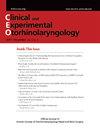Real-Time Light-Guided Vocal Fold Injection via the Cricothyroid Membrane in Unilateral Vocal Fold Paralysis: A Human Pilot Study
IF 2.9
3区 医学
Q1 OTORHINOLARYNGOLOGY
引用次数: 0
Abstract
Objectives. Vocal fold injection (VFI) via the cricothyroid (CT) membrane is used to treat various diseases affecting the vocal folds. The technical challenges of this technique are mainly related to the invisibility of the needle. Real-time light-guided VFI (RL-VFI) was recently developed for injection under simultaneous light guidance in the CT approach. Herein, we present the first clinical trial of RL-VFI, in which we investigated the feasibility and safety of this new technique in unilateral vocal fold paralysis (VFP). Methods. This prospective pilot study enrolled 40 patients, who were treated with RL-VFI for unilateral VFP between September 2020 and August 2021. Adverse events were monitored during the procedure and for 4 weeks postoperatively. The Voice Handicap Index-10, the GRBAS (grade, roughness, breathiness, asthenia, and strain) scale, aerodynamic studies, and acoustic analyses were evaluated to compare the voice improvement after 4 weeks with the baseline values. Results. The needle tip was intuitively identified by the red light. The mean procedure time was 95.6±40.6 seconds for the initial injection, while the additional injection required 79.2±70.5 seconds. The injection was performed under light guidance without additional manipulation after the needle reached the intended point. No acute or delayed adverse events were reported. Among the 40 patients, 36 completed voice analyses after 4 weeks. Subjective and objective voice parameters, including the Voice Handicap Index-10, GRBAS scale, maximum phonation time, mean expiratory airflow, fundamental frequency, jitter, shimmer, and noise-to-harmonics ratio improved significantly after RL-VFI (P<0.05), while the expiratory volume was maintained. Conclusion. RL-VFI is feasible and safe for treating patients with unilateral VFP. This technique is anticipated to improve the precision and safety of the CT approach in the treatment of unilateral VFP. This study provides a rationale for further structured clinical studies.经甲旁膜实时光导下声带注射治疗单侧声带麻痹的初步研究
目标。经环甲(CT)膜的声带注射(VFI)用于治疗各种影响声带的疾病。这项技术的技术挑战主要与针的不可见性有关。实时光导VFI (Real-time light-guided VFI, RL-VFI)是最近发展起来的一种用于CT入路同时光导下注射的技术。在此,我们提出了RL-VFI的第一个临床试验,在该试验中,我们研究了这种新技术在单侧声带麻痹(VFP)中的可行性和安全性。方法。这项前瞻性试点研究招募了40名患者,他们在2020年9月至2021年8月期间接受了RL-VFI治疗单侧VFP。在手术期间和术后4周监测不良事件。评估嗓音障碍指数-10、GRBAS(分级、粗糙度、呼吸、乏力和应变)量表、空气动力学研究和声学分析,将4周后的声音改善与基线值进行比较。结果。针尖被红光直观地识别出来。初始注射的平均时间为95.6±40.6秒,附加注射的平均时间为79.2±70.5秒。针头到达预定点后,在光导下进行注射,无需额外操作。没有急性或迟发性不良事件的报道。40例患者中,36例在4周后完成声音分析。RL-VFI后主客观语音指标包括语音障碍指数-10、GRBAS量表、最大发声时间、平均呼气气流、基频、抖动、闪烁、噪声-谐波比均有显著改善(P<0.05),而呼气量保持不变。结论。RL-VFI治疗单侧VFP是可行且安全的。该技术有望提高CT入路治疗单侧VFP的精度和安全性。本研究为进一步的结构化临床研究提供了理论依据。
本文章由计算机程序翻译,如有差异,请以英文原文为准。
求助全文
约1分钟内获得全文
求助全文
来源期刊
CiteScore
4.90
自引率
6.70%
发文量
49
审稿时长
6-12 weeks
期刊介绍:
Clinical and Experimental Otorhinolaryngology (Clin Exp Otorhinolaryngol, CEO) is an international peer-reviewed journal on recent developments in diagnosis and treatment of otorhinolaryngology-head and neck surgery and dedicated to the advancement of patient care in ear, nose, throat, head, and neck disorders. This journal publishes original articles relating to both clinical and basic researches, reviews, and clinical trials, encompassing the whole topics of otorhinolaryngology-head and neck surgery.
CEO was first issued in 2008 and this journal is published in English four times (the last day of February, May, August, and November) per year by the Korean Society of Otorhinolaryngology-Head and Neck Surgery. The Journal aims at publishing evidence-based, scientifically written articles from different disciplines of otorhinolaryngology field.
The readership contains clinical/basic research into current practice in otorhinolaryngology, audiology, speech pathology, head and neck oncology, plastic and reconstructive surgery. The readers are otolaryngologists, head and neck surgeons and oncologists, audiologists, and speech pathologists.

 求助内容:
求助内容: 应助结果提醒方式:
应助结果提醒方式:


